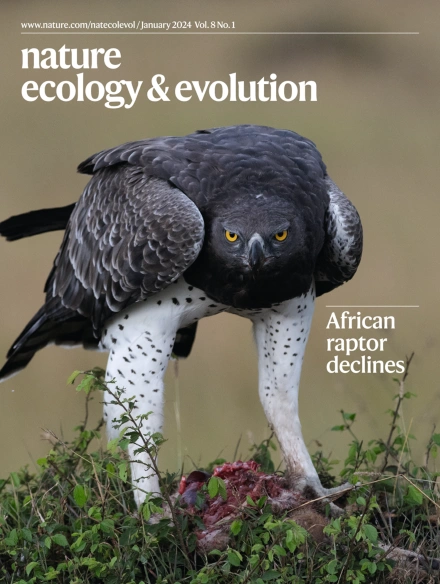整个陆地生物圈广泛的生态新奇
IF 13.9
1区 生物学
Q1 ECOLOGY
引用次数: 0
摘要
人类活动已经将许多野生和半野生生态系统转变为前所未有的新状态。如果不知道驱动这种新奇事物出现的当前分布,预测未来的生态系统状态并为保护和恢复政策提供信息仍然是困难的。在这里,我们构建了产生新情况的三个关键驱动因素的全球地图——气候变化、退化和植物区系破坏——并将它们总结为总新颖性暴露的衡量标准。我们表明,陆地生物圈广泛暴露在新的条件下,58%的总面积暴露在高水平的总新新性中。所有气候区域和生物群系都暴露在大量的新奇事物中。各个驱动因素的相对贡献因气候区域而异,气候变化和衰减是全球最大的驱动因素。无论是否受到正式保护,保护区和重点生物多样性区具有相似的暴露,保护区内58%的细胞具有高总新颖性,重点生物多样性区内56%的细胞具有高总新颖性。我们的研究结果强调了调查生态系统和生物多样性对日益增长的生态新颖性的响应对于为生物圈管理提供信息的重要性。本文章由计算机程序翻译,如有差异,请以英文原文为准。


Widespread ecological novelty across the terrestrial biosphere
Human activities have transformed many wild and semiwild ecosystems into novel states without historical precedent. Without knowing the current distribution of what drives the emergence of such novelty, predicting future ecosystem states and informing conservation and restoration policies remain difficult. Here we construct global maps of three key drivers generating novel conditions—climate change, defaunation and floristic disruption—and summarize them to a measure of total novelty exposure. We show that the terrestrial biosphere is widely exposed to novel conditions, with 58% of the total area exposed to high levels of total novelty. All climatic regions and biomes are exposed to substantial levels of novelty. Relative contributions of individual drivers vary between climatic regions, with climate changes and defaunation the largest contributors globally. Protected areas and key biodiversity areas, whether formally protected or not, have similar exposure, with high total novelty experienced in 58% of cells inside protected areas and 56% inside key biodiversity areas. Our results highlight the importance of investigating ecosystem and biodiversity responses to rising ecological novelty for informing actions towards biosphere stewardship. Even outside urban and agricultural areas, ecosystems are vastly transformed as a result of human activities. Here the authors map patterns in climate change, defaunation and floristic disruption to quantify the global exposure of ecosystems to novel conditions.
求助全文
通过发布文献求助,成功后即可免费获取论文全文。
去求助
来源期刊

Nature ecology & evolution
Agricultural and Biological Sciences-Ecology, Evolution, Behavior and Systematics
CiteScore
22.20
自引率
2.40%
发文量
282
期刊介绍:
Nature Ecology & Evolution is interested in the full spectrum of ecological and evolutionary biology, encompassing approaches at the molecular, organismal, population, community and ecosystem levels, as well as relevant parts of the social sciences. Nature Ecology & Evolution provides a place where all researchers and policymakers interested in all aspects of life's diversity can come together to learn about the most accomplished and significant advances in the field and to discuss topical issues. An online-only monthly journal, our broad scope ensures that the research published reaches the widest possible audience of scientists.
 求助内容:
求助内容: 应助结果提醒方式:
应助结果提醒方式:


